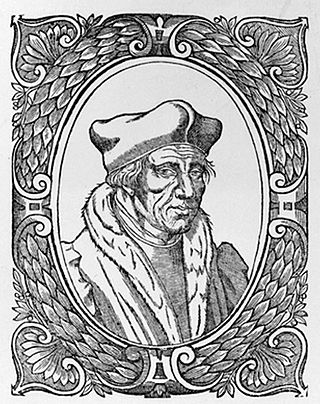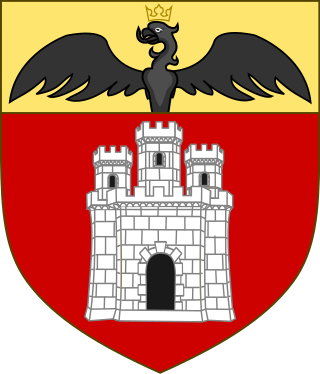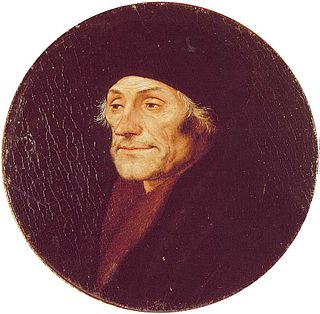
Agostino Giustiniani (born Pantaleone Giustiniani; 1470 - 1536) was an Italian Catholic bishop, linguist and geographer.

Agostino Giustiniani (born Pantaleone Giustiniani; 1470 - 1536) was an Italian Catholic bishop, linguist and geographer.
Giustiniani was born at Genoa into a noble Giustiniani family. His father had been ambassador of the Republic of Genoa at Milan, while his grandfather had been governor of Chios.
Giustiniani spent some years in Valencia, Spain, before joining the Dominican order in 1487. He studied Greek, Hebrew, Aramaic and Arabic, and in 1514 began preparing a polyglot edition of the Bible. As Bishop of Nebbio in Corsica, he took part in some of the earlier sittings of the Lateran council (1516–1517), but, in consequence of party complications, withdrew to his diocese, and ultimately to France, where he became a pensioner of Francis I, and was the first to occupy a chair of Hebrew and Arabic in the University of Paris. [1]
After an absence from Corsica for a period of five years, during which he visited England and the Low Countries, and became acquainted with Erasmus and Sir Thomas More, he returned to Nebbio, about 1522. There he remained, with comparatively little intermission, until in 1536, when, while returning from a visit to Genoa, he perished in a storm at sea. He was the possessor of a very fine library, which he bequeathed to the republic of Genoa. Of his projected polyglot only the Psalter was published (Psalterium Hebraeum, Graecum, Arabicum, et Chaldaicum, Genoa, 1516). Besides the Hebrew text, the Septuagint translation, the Chaldee paraphrase, and an Arabic version, it contains the Vulgate translation, a new Latin translation by the editor, a Latin translation of the Chaldee paraphrase, and a collection of scholia . Giustiniani printed 2,000 copies at his own expense, including fifty in vellum for presentation to the sovereigns of Europe and Asia; but the sale of the work did not encourage him to proceed with the New Testament, which he had also prepared for the press. [1]
Besides an edition of the Book of Job , containing the original text, the Vulgate, and a new translation, he published a Latin version of The Guide for the Perplexed of Maimonides (Moreh Nevukhim, Director dubitantium aut perplexorum, 1520), and also edited in Latin the Aureus libellus of Aeneas Platonicus, and the Timaeus of Chalcidius. In 1526-1530 he wrote a description of Corsica entitle Dialogo nominato Corsica. His annals of Genoa (Castigatissimi Annali di Genova) were published posthumously in 1537. [1]

The Vulgate, sometimes referred to as the Latin Vulgate, is a late-4th-century Latin translation of the Bible.

Jacques Lefèvre d'Étaples was a French theologian and a leading figure in French humanism. He was a precursor of the Protestant movement in France. The "d'Étaples" was not part of his name as such, but used to distinguish him from Jacques Lefèvre of Deventer, a less significant contemporary who was a friend and correspondent of Erasmus. Both are also sometimes called by the German version of their name, Jacob/Jakob Faber. He himself had a sometimes tense relationship with Erasmus, whose work on Biblical translation and in theology closely paralleled his own.

The Complutensian Polyglot Bible is the name given to the first printed polyglot of the entire Bible. The edition was initiated and financed by Cardinal Francisco Jiménez de Cisneros (1436–1517) and published by Complutense University in Alcalá de Henares, Spain. It includes the first printed editions of the Greek New Testament, the complete Septuagint, and the Targum Onkelos. Of the 600 six-volume sets which were printed, only 123 are known to have survived to date.

Yehuda Alharizi, also Judah ben Solomon Harizi or al-Harizi, was a rabbi, translator, poet, and traveler active in Spain in the Middle Ages. He was supported by wealthy patrons, to whom he wrote poems and dedicated compositions.

Samuel Bochart was a French Protestant biblical scholar, a student of Thomas Erpenius and the teacher of Pierre Daniel Huet. His two-volume Geographia Sacra seu Phaleg et Canaan exerted a profound influence on seventeenth-century Biblical exegesis.

Mario di Calasio was an Italian Minorite friar.

Benito Arias Montano was a Spanish orientalist and polymath that was active mostly in Spain. He was also editor of the Antwerp Polyglot. He reached the high rank of Royal Chaplain to King Philip II of Spain. His work was censured by the Spanish Inquisition when rabbinical references were included into his Antwerp Polyglot Bible.
Ibrahim al-Haqilani was a Maronite Catholic philosopher and linguist involved in the translation of the Bible into Arabic. He translated several Arabic works into Latin, the most important of which was the Chronicon orientale attributed to Ibn al-Rahib.

The House of Giustiniani was the name of a prominent Italian family which originally belonged to Venice, but also established itself in Genoa, and at various times had representatives in Naples, Canary Islands, Corsica and in the islands of the Archipelago, where they had been the last Genoese rulers of the Aegean island of Chios, which had been a family possession for two centuries until 1566. The family claimed descent from Byzantine emperor Justinian I.

A polyglot is a book that contains side-by-side versions of the same text in several different languages. Some editions of the Bible or its parts are polyglots, in which the Hebrew and Greek originals are exhibited along with historical translations. Polyglots are useful for studying the history of the text and its interpretation.

The Diocese of Ajaccio is a Latin Church ecclesiastical jurisdiction or diocese of the Catholic Church in France. The diocese comprises the whole of the island of Corsica.
Jewish printers were quick to take advantages of the printing press in publishing the Hebrew Bible. While for synagogue services written scrolls were used, the printing press was very soon called into service to provide copies of the Hebrew Bible for private use. All the editions published before the Complutensian Polyglot were edited by Jews; but afterwards, and because of the increased interest excited in the Bible by the Reformation, the work was taken up by Christian scholars and printers; and the editions published by Jews after this time were largely influenced by these Christian publications. It is not possible in the present article to enumerate all the editions, whole or partial, of the Hebrew text. This account is devoted mainly to the incunabula.
Guy Lefèvre de la Boderie was a French Orientalist, Bible scholar and poet.
The Diocese of Mariana and Acci or Diocese of Accia and Mariana was a Roman Catholic ecclesiastical territory. It is now a titular see.

Novum Instrumentum omne was the first published New Testament in Greek (1516). It was prepared by Desiderius Erasmus (1466–1536) and printed by Johann Froben (1460–1527) of Basel. Although the first printed Greek New Testament was the Complutensian Polyglot (1514), it was the second to be published (1516). Erasmus used several Greek manuscripts housed in Basel, but some verses in Revelation he translated from the Latin Vulgate.

Elias Hutter was a German Hebraist.

The Bible translations into Latin date back to classical antiquity.
The Diocese of Aleria was a Roman Catholic diocese of the Latin rite, in the center of the eastern coast of the island of Corsica in the Department of Haute-Corse. The town of Aleria was subject to repeated raids by Arab fleets in the eighth and ninth centuries, and eventually abandoned, many of its people fleeing to the mainland. The bishop moved to a secure stronghold to the north. From at least the eleventh century, the diocese was a suffragan of the metropolitan archdiocese of Pisa. The diocese was suppressed by the Civil Constitution of the Clergy in 1790, and was not revived after the Concordat of 1801 between the French Consulate and the Papacy. It has been a titular diocese since 2002.

The Diocese of Nebbio was a Roman Catholic diocese located in the town of Saint-Florent in Corsica. The Cathedral is on a low hill one mile from the port of Saint-Florent. In the Medieval period the Bishop of Nebbio was also the temporal lord of nearly all the lands in his diocese. In 1667, Nebbio was completely abandoned and the bishop lived in Saint-Florent, a town of about 200 inhabitants, under the dominion of the Republic of Genoa. The diocese had some 22 places. The Cathedral Chapter had two dignities, the Archdeacon and the Provost, and three Canons. In 1770 the diocese was under the dominion of the King of France, and Saint-Fleur had about 600 inhabitants. The Chapter of the Cathedral still existed, with two dignities and six Canons.

The Col de Santo Stefano Corsican: Bocca di San Stefanu) is a mountain pass in the Haute-Corse department of Corsica, France. It is one of the main passes in Corsica, running between the massifs of Monte Stello to the north and Monte Astu to the south. It provides a route from the Saint-Florent region to the northwest and Biguglia in the eastern coastal plain.